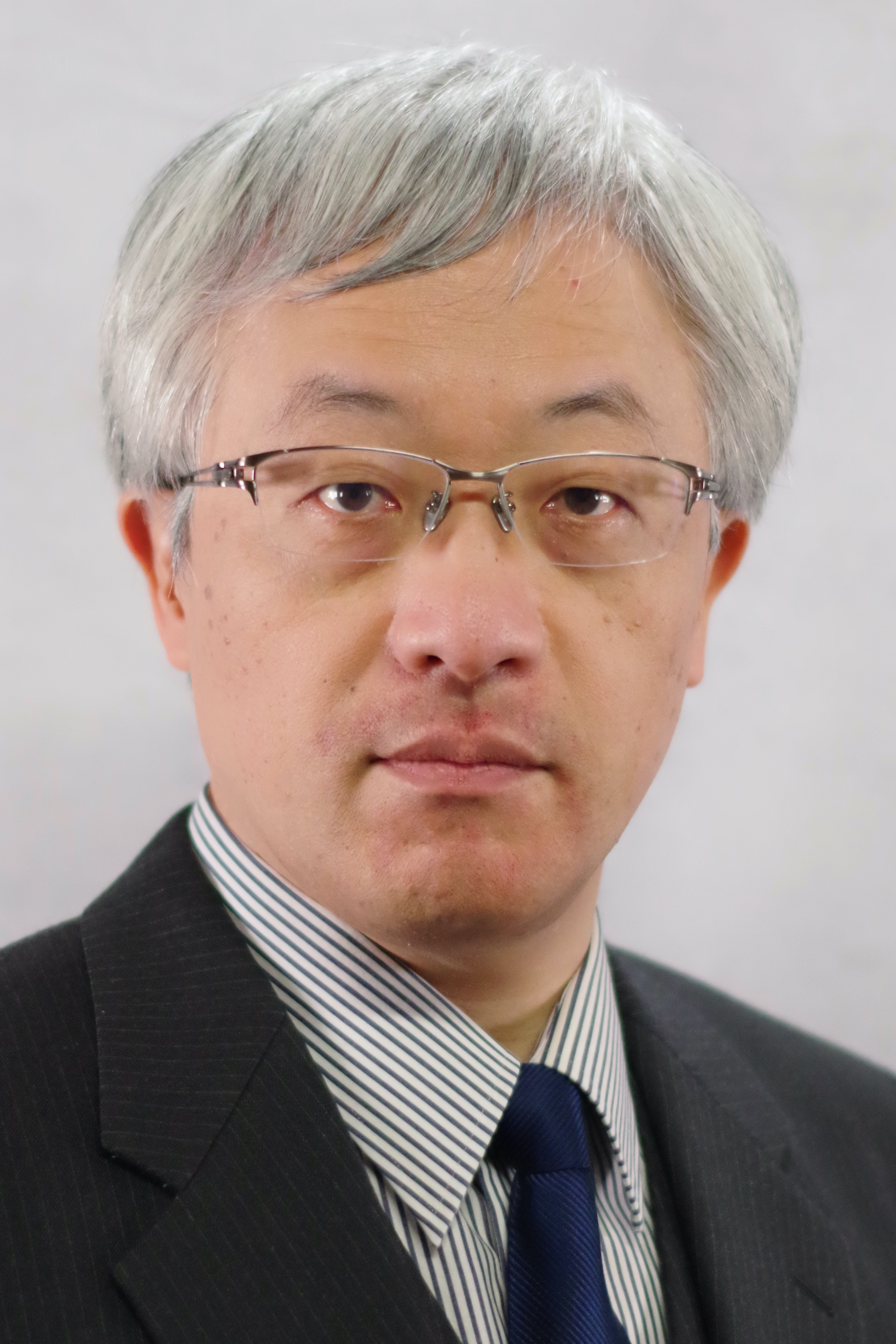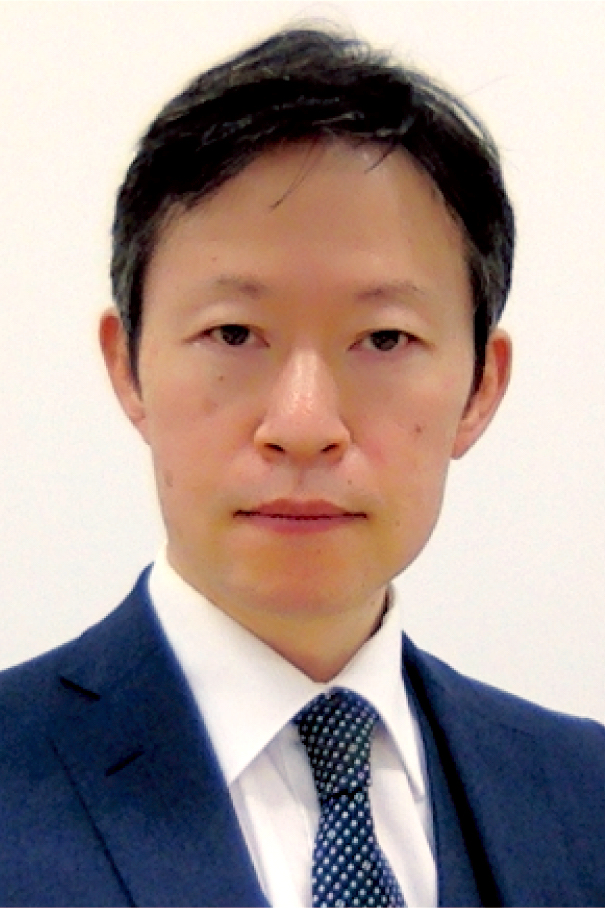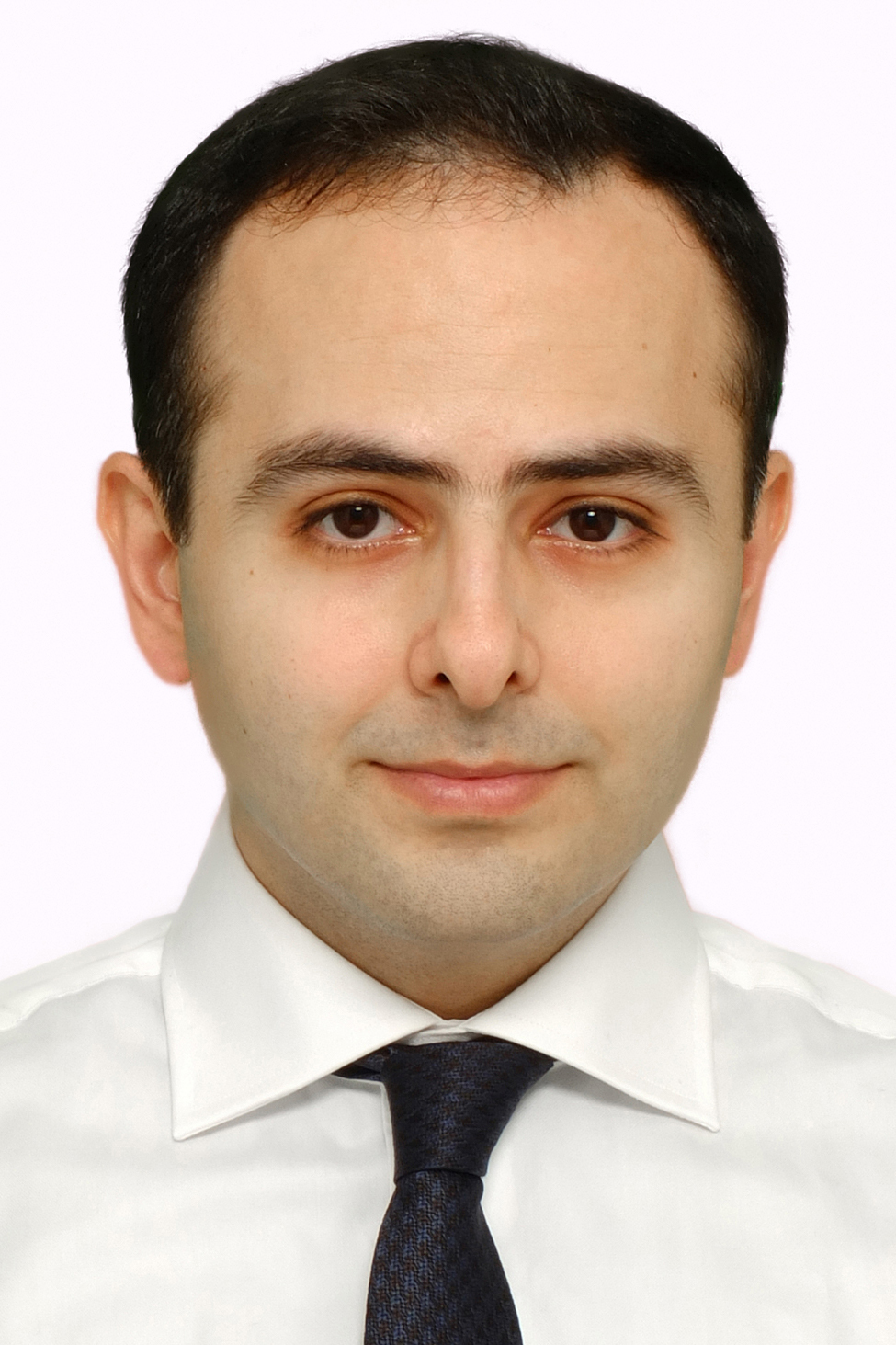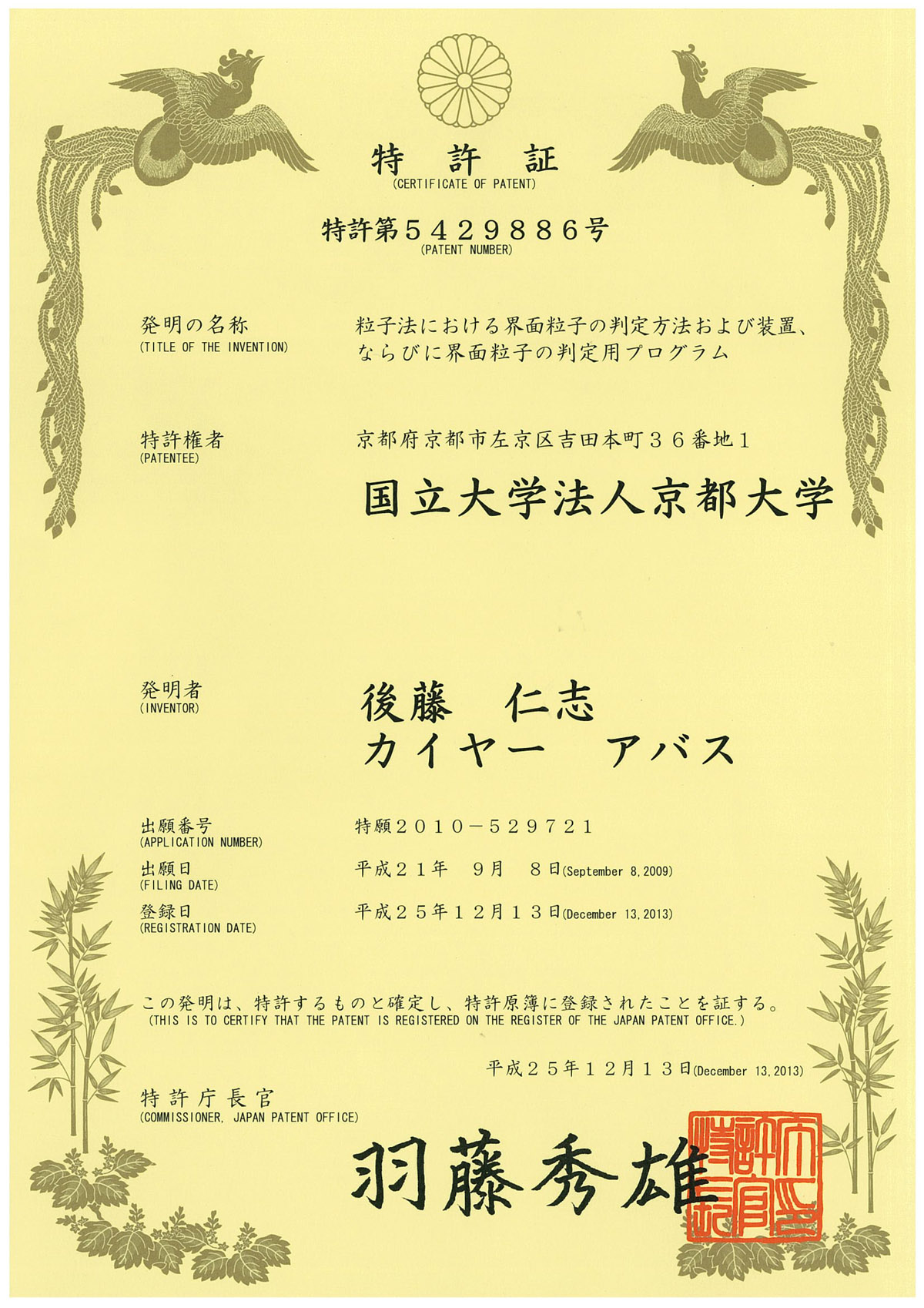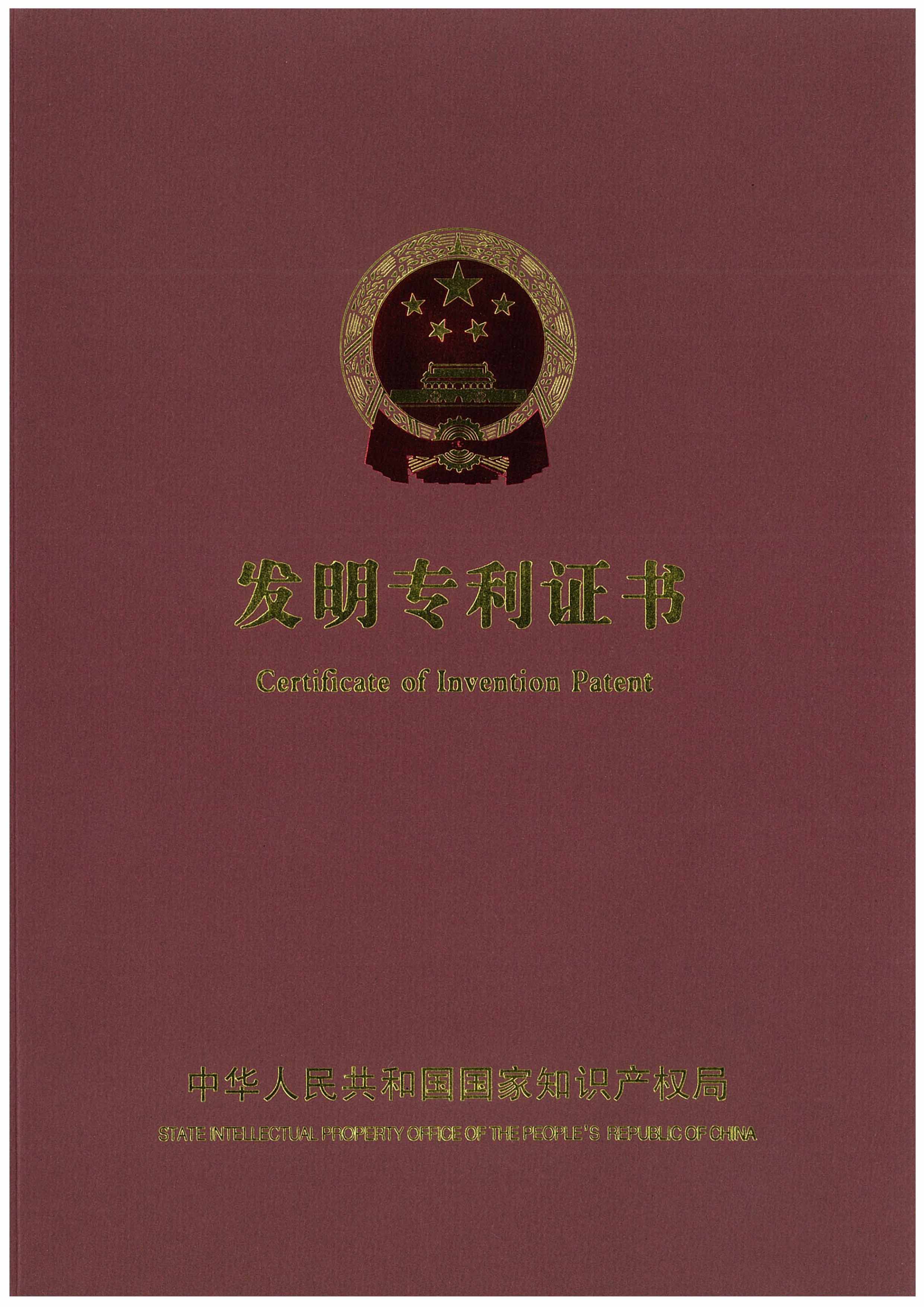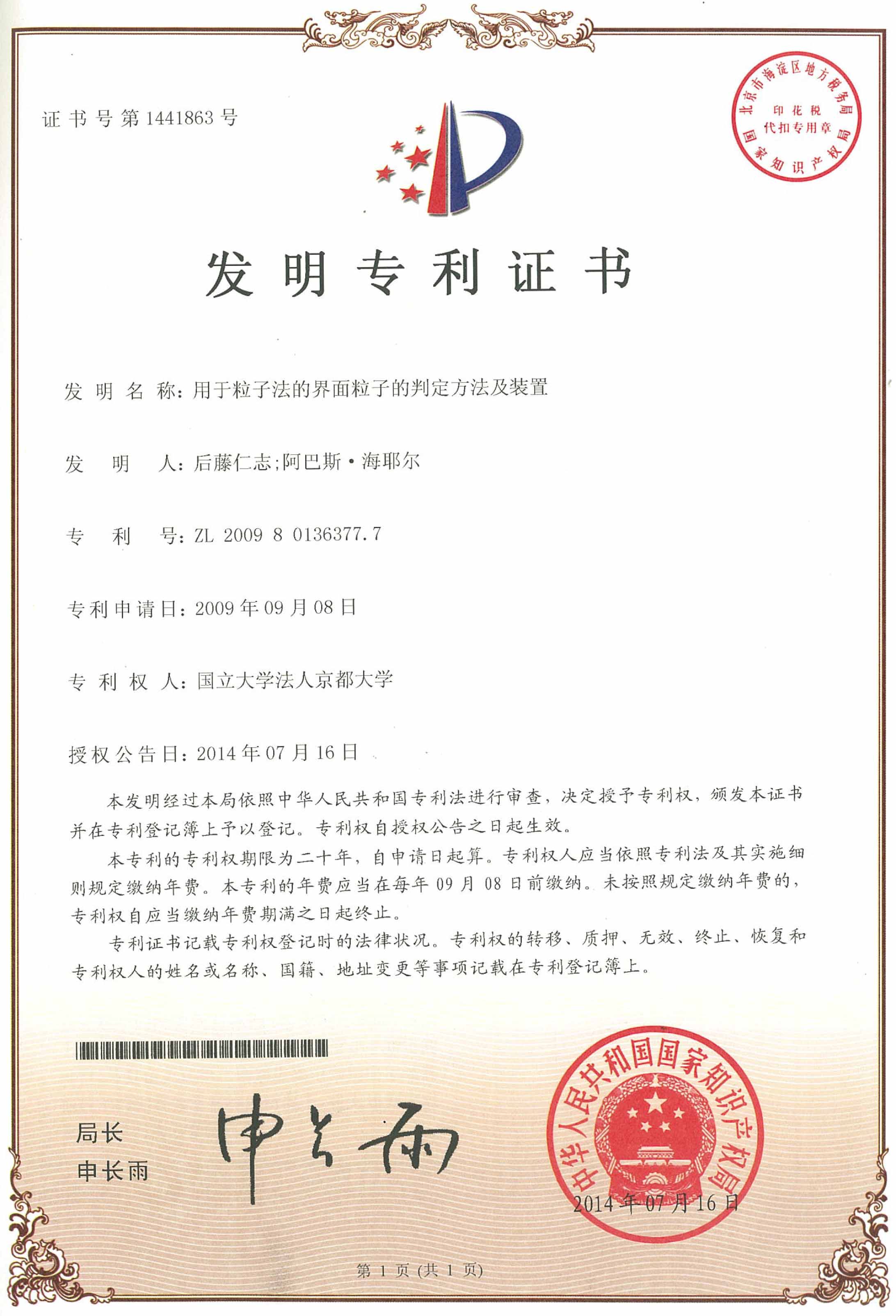Welcome to our Research Team
PMR-Kyoto is a joint research team of the GOTOH Hitoshi, HARADA Eiji and KHAYYER Abbas laboratories at the Graduate School of Engineering, Kyoto University. The research team aims to contribute to the enhancement of engineering science through the multidisciplinary development of particle-based simulations. The simulations cover a wide range of subjects, from fluid motion and corresponding interactions in natural environments to crowd behaviour in urban areas. We would like to explore the essence of the phenomena by means of computational mechanics using particle system simulations. This page provides an overview of the research activities of our research team.
Hitoshi Gotoh, Professor |
Eiji Harada, Professor |
Abbas Khayyer, Associate Professor |
Undergraduate students who are interested in joining a laboratory in our research team and students from other universities who are interested in studying as graduate students in our laboratories can find information about the overall student life in our research team on the 'Life of Students' page. Information for prospective doctoral students is also available on this page.
[Named in the World’s top 2% Scientists List 2025 by Stanford University]
Two members of our research team, Hitoshi Gotoh and Abbas Khayyer have been included in the World’s top 2% Scientists List by Stanford University (Listed for 4 consecutively years since 2021). This list includes the top 2% of the world's scientists in 22 major fields, selected by an evaluation method based on the number of citations, h-index, and other metrics. Kyoto University as a whole has 251 scientists on the Full Career Impact List and 148 on the Single-Year Impact List.
[Textbook “Advanced Particle Methods” has been released.]
Textbook “Advanced Particle Methods”, co-authored by Hitoshi Gotoh and Abbas Khayyer, has been released from Springer (April 6, 2025). For more information, please see the Springer's web page.

Advanced Particle Methods
by Hitoshi Gotoh and Abbas Khayyer
285 pages, ISBN: 978-981-97-7932-1, USD 99.99 (JPY12,154).
[CEJ Award 2023]
Takumi Tazaki, Eiji Harada and Hitoshi Gotoh had won the CEJ Award 2023.
Title: Grain-scale investigation of swash zone sediment transport on a gravel beach using DEM-MPS coupled scheme. Authors: Takumi Tazaki, Eiji Harada and Hitoshi Gotoh

[CEJ Citation Award 2023]
Yuma Shimizu, Abbas Khayyer and Hitoshi Gotoh had won the CEJ Citation Award 2023.
Title: An enhanced multiphase ISPH-based method for accurate modeling of oil spill.
Authors: Yuma Shimizu, Abbas Khayyer, Hitoshi Gotoh and Ken Nagashima

[SPHERIC Zhuhai 2024 Best Paper Award]
Takafumi Gotoh (Ph.D. student), Abbas Khayyer, Daiki Sakoda (Master course student) and Hitoshi Gotoh had won the Best Paper Award of 2024 SPHERIC Zhuhai International Workshop.
Title: Development of an accurate updated Lagrangian SPH structure model for simulation of laminated composite structures
Authors: Takafumi Gotoh, Abbas Khayyer, Daiki Sakoda, Chun Hean Lee, Antonio Gil, Hitoshi Gotoh, Javier Bonet

[Named in the World’s top 2% Scientists List 2024 by Stanford University]
Two members of our research team, Hitoshi Gotoh and Abbas Khayyer have been included in the World’s top 2% Scientists List by Stanford University (Listed for 4 consecutively years since 2021). This list includes the top 2% of the world's scientists in 22 major fields, selected by an evaluation method based on the number of citations, h-index, and other metrics. Kyoto University as a whole has 457 scientists on the Full Career Impact List and 317 on the Single-Year Impact List.
[Three papers were selected for Web of Science Highly Cited Paper]
The following three papers were selected for the Web of Science Highly Cited Paper (September/October 2024).
[1] On the state-of-the-art of particle methods for coastal and ocean engineering. Coastal Eng. J. 60(1): 79-103, 2018.
[2] Comparative study on accuracy and conservation properties of two particle regularization schemes and proposal of an optimized particle shifting scheme in ISPH context. J. Compt. Phys. 332(1): 236-256,2017.
[3] An enhanced ISPH-SPH coupled method for simulation of incompressible fluid-elastic structure interactions. Comput. Phys. Commun. 232: 139-164, 2018.Highly Cited Paper received enough citations to place it in the top 1% of the academic field ( [1]:Engineering, [2] and [3]:Physics ).
[Named in the World’s top 2% Scientists List 2023 by Stanford University]
Two members of our research team, Hitoshi Gotoh and Abbas Khayyer have been included in the World’s top 2% Scientists List by Stanford University (Listed for 3 consecutively years since 2021). This list includes the top 2% of the world's scientists in 22 major fields, selected by an evaluation method based on the number of citations, h-index, and other metrics. Kyoto University as a whole has 197 scientists on the Full Career Impact List (193 last year) and 104 on the Single-Year Impact List.
[Five papers were selected for Web of Science Highly Cited Paper]
The following five papers were selected for the Web of Science Highly Cited Paper (December 2022).
[1] On the state-of-the-art of particle methods for coastal and ocean engineering. Coastal Eng. J. 60(1): 79-103, 2018.
[2] Comparative study on accuracy and conservation properties of two particle regularization schemes and proposal of an optimized particle shifting scheme in ISPH context. J. Compt. Phys. 332(1): 236-256,2017.
[3] An enhanced ISPH-SPH coupled method for simulation of incompressible fluid-elastic structure interactions. Comput. Phys. Commun. 232: 139-164, 2018.
[4] Multi-resolution ISPH-SPH for accurate and efficient simulation of hydroelastic fluid-structure interactions in ocean engineering. Ocean Eng. 226: Article 108652.
[5] A coupled incompressible SPH-Hamiltonian SPH solver for hydroelastic FSI corresponding to composite structures. Appl. Math. Modeling. 94: 242-271.
Highly Cited Paper received enough citations to place it in the top 1% of the academic field ( [1],[4] and [5]:Engineering, [2] and [3]:Physics ).
[Named in the World’s top 2% Scientists List 2022 by Stanford University]
Two members of our research team, Hitoshi Gotoh and Abbas Khayyer have been included in the World’s top 2% Scientists List by Stanford University. This list includes the top 2% of the world's scientists in 22 major fields, selected by an evaluation method based on the number of citations, h-index, and other metrics. Kyoto University as a whole has 193 scientists on the Full Career Impact List (287 last year) and 101 on the Single-Year Impact List.
[SPHERIC Xi’an 2022 Best Paper Award]
Abbas Khayyer, Hitoshi Gotoh and Yuma Shimizu had won the Best Paper Award of 2022 SPHERIC Xi'an International Workshop.
Title: Development of an accurate updated Lagrangian SPH structure model for simulation of laminated composite structures
Authors: Abbas Khayyer, Hitoshi Gotoh and Yuma Shimizu
Abbas Khayyer, the first author, received the certificate on behalf of the authors.
.jpg)
[Named in the World’s top 2% Scientists List by Stanford University]
Two members of our research team, Hitoshi Gotoh and Abbas Khayyer have been included in the World’s top 2% Scientists List by Stanford University. This list includes the top 2% of the world's scientists in 22 major fields, selected by an evaluation method based on the number of citations, h-index, and other metrics. The list includes 287 scientists of Kyoto University as a whole.
[Coastal Engineering Journal Reviewer Award 2020]
Eiji Harada and Yuma Shimizu received the Coastal Engineering Journal Reviewer Award 2020. This award is given to reviewers who have made significant contributions in the review of submitted papers to CEJ over the past year. Two of the seven award winners in 2020 are members of this research team.
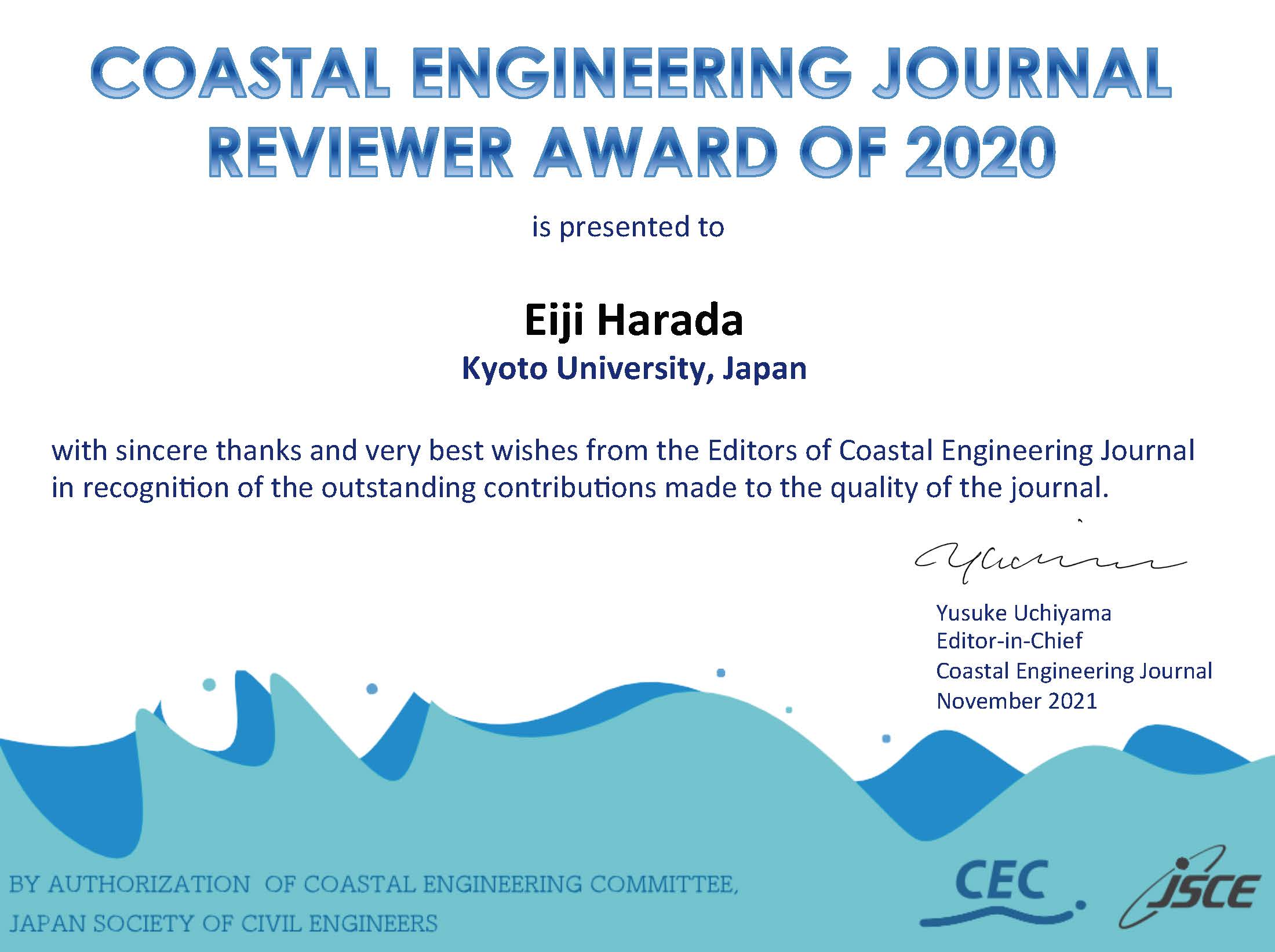
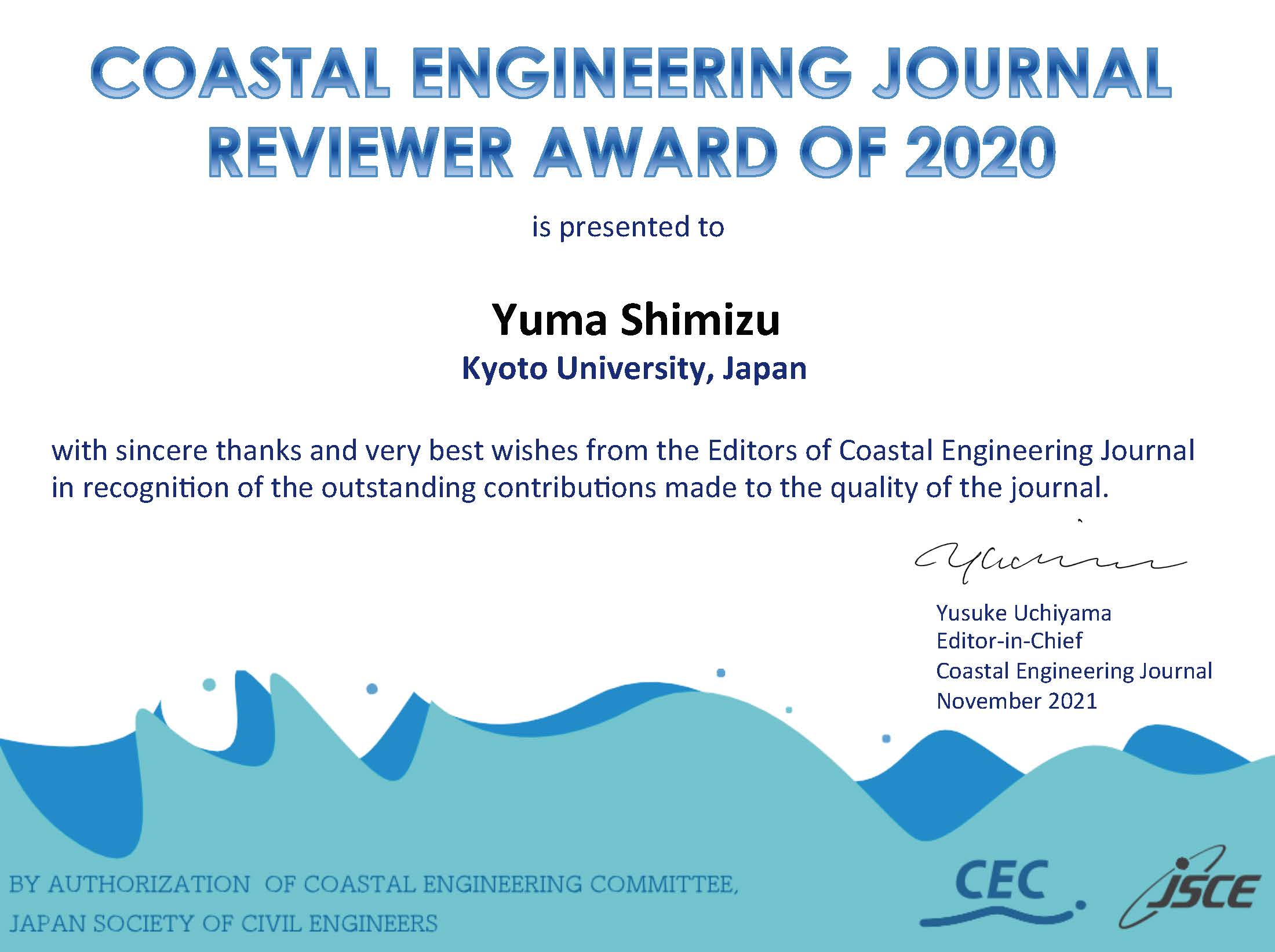
[Four papers were selected for Web of Science Highly Cited Paper]
The following three papers were selected for the Web of Science Highly Cited Paper (January/February, 2021).
| [1] | On the state-of-the-art of particle methods for coastal and ocean engineering. Coastal Eng. J. 60(1): 79-103, 2018. |
| [2] | Comparative study on accuracy and conservation properties of two particle regularization schemes and proposal of an optimized particle shifting scheme in ISPH context. J. Compt. Phys. 332 (1): 236-256, 2017. |
| [3] | An enhanced ISPH-SPH coupled method for simulation of incompressible fluid-elastic structure interactions. Comput. Phys. Commun. 232: 139-164, 2018. |
| [4] | Enhancement of stability and accuracy of the moving particle semi-implicit method, J. Compt. Phys. 230(8): 3039-3118,2011. |
Highly Cited Paper received enough citations to place it in the top 1% of the academic field ( [1]:Engineering, [2],[3] and [4]:Physics ).
[Three papers were selected for Web of Science Highly Cited Paper]
The following three papers were selected for the Web of Science Highly Cited Paper (November/December, 2020).
| [1] | On the state-of-the-art of particle methods for coastal and ocean engineering. Coastal Eng. J. 60(1): 79-103, 2018. |
| [2] [3] |
Comparative study on accuracy and conservation properties of two particle regularization schemes and proposal of an optimized particle shifting scheme in ISPH context. J. Compt. Phys. 332 (1): 236-256, 2017.
An enhanced ISPH-SPH coupled method for simulation of incompressible fluid-elastic structure interactions. Comput. Phys. Commun. 232: 139-164, 2018. |
Highly Cited Paper received enough citations to place it in the top 1% of the academic field ( [1]:Engineering, [2] and [3]:Physics ).
[CEJ Citation Award 2019]
Hitoshi Gotoh and Abbas Khayyer had won the CEJ Citation Award 2019.
Title: On the state-of-the-art of particle methods for coastal and ocean engineering.
Authors: Hitoshi Gotoh and Abbas Khayyer
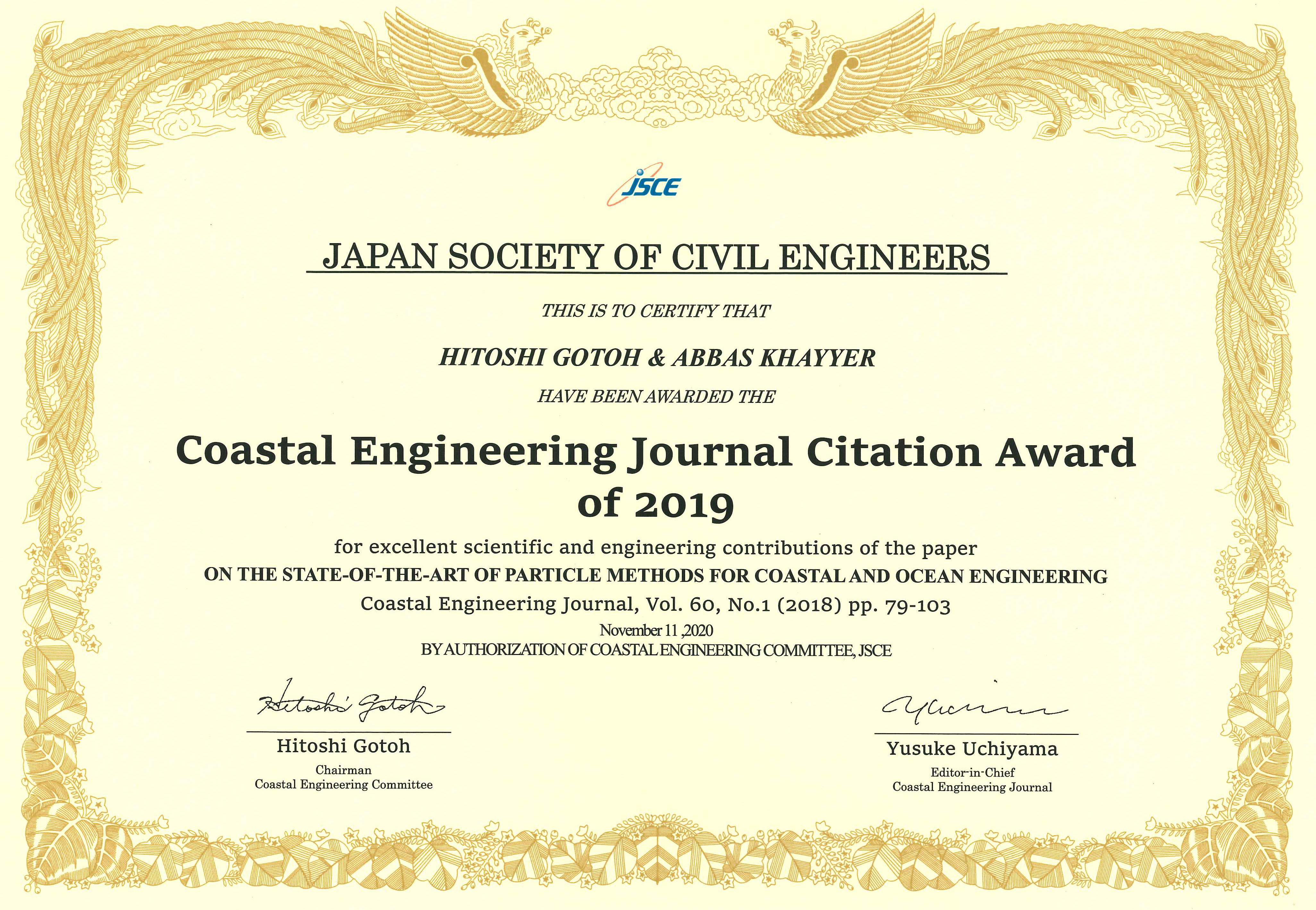
[Two papers were selected for Web of Science Highly Cited Paper]
The following two papers were selected for the Web of Science Highly Cited Paper (January/February, 2019).
| [1] | On the state-of-the-art of particle methods for coastal and ocean engineering. Coastal Eng. J., 60 (1): 79-103, 2018. |
| [2] |
Comparative study on accuracy and conservation properties of two particle regularization schemes and proposal of an optimized particle shifting scheme in ISPH context. J. Compt. Phys. 332 (1): 236-256, 2017. |
Highly Cited Paper received enough citations to place it in the top 1% of the academic field ( [1]:Engineering, [2]:Physics ).
[3rd position in Most Cited Journal of Computational Physics Articles]
Comparative study on accuracy and conservation properties of two particle regularization schemes and proposal of an optimized particle shifting scheme in ISPH context (Volume 332, Issue 1, March 2017) has been listed at the 3rd position in the Most Cited Journal of Computational Physics Articles. Among papers published on JCP since 2016, highly cited papers has been found on the basis of Scopus data.
[Special issue of SPH published by Coastal Engineering Journal]
The special issue of SPH, where the members of our research group (Gotoh & Khayyer) served as Guest Editors, has been published by Coastal Engineering Journal (Taylor & Francis).
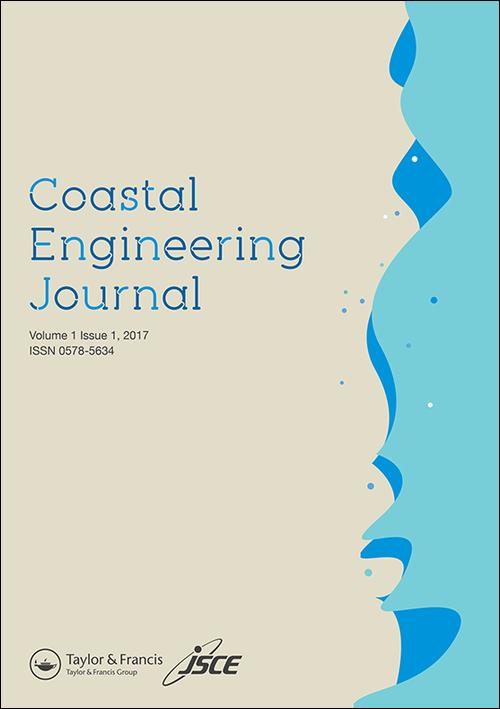
Special issue on SPH (Smoothed Particle Hydrodynamics) for Coastal and Ocean Engineering
Guest Editors: Hitoshi Gotoh & Abbas Khayyer
Published online: 20 Feb 2019
[Abbas Khayyer received the C. H. Kim Award.]
Abbas Khayyer received the C. H. Kim Award. This award was founded in 2006 to commemorate Dr. Cheung Hun Kim (Texas A & M University), the founding member of ISOPE (International Society of Offshore and Polar Engineers) and is awarded to one researcher who made a remarkable contribution to ocean engineering. Abbas Khayyer is the youngest of all the prize winners and the first awarded researcher from Kyoto University. In addition, he is the first Iranian researcher to receive this award.
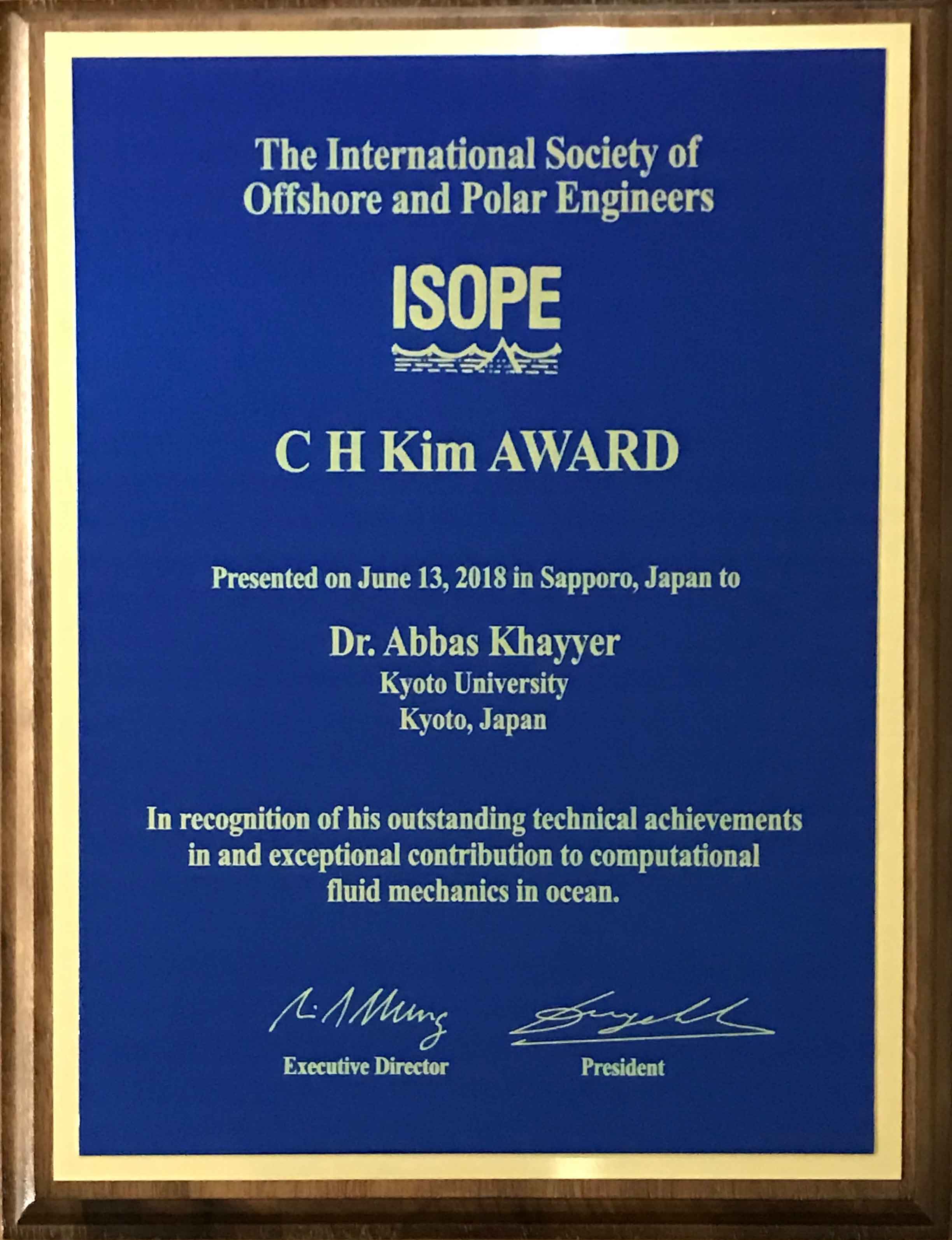
[Top position in Most Cited Applied Ocean Research Articles]
Our publication: On enhancement of Incompressible SPH method for simulation of violent sloshing flows (Applied Ocean Research, Volume 46, Issue , June 2014) has been listed in the top position in the Most Cited Applied Ocean Research Articles.(as of January, 2018).
[12th position in Most Cited Journal of Computational Physics Articles]
Our paper: Enhancement of stability and accuracy of the moving particle semi-implicit method (Volume 230, Issue 8, April 2011) has been listed in the Most Cited Journal of Computational Physics Articles. Among papers published on JCP since 2011, highly cited papers has been found on the basis of Scopus data.
[VF-2016 Best Paper Award]
Hiroyuki Ikari and Hitoshi Gotoh had won the Best Paper Award in 3rd International Conference on Violent Flows 2016. Title: Numerical modeling of dike erosion due to overtopping flow using Incompressible SPH method Authors: Hiroyuki Ikari and Hitoshi Gotoh
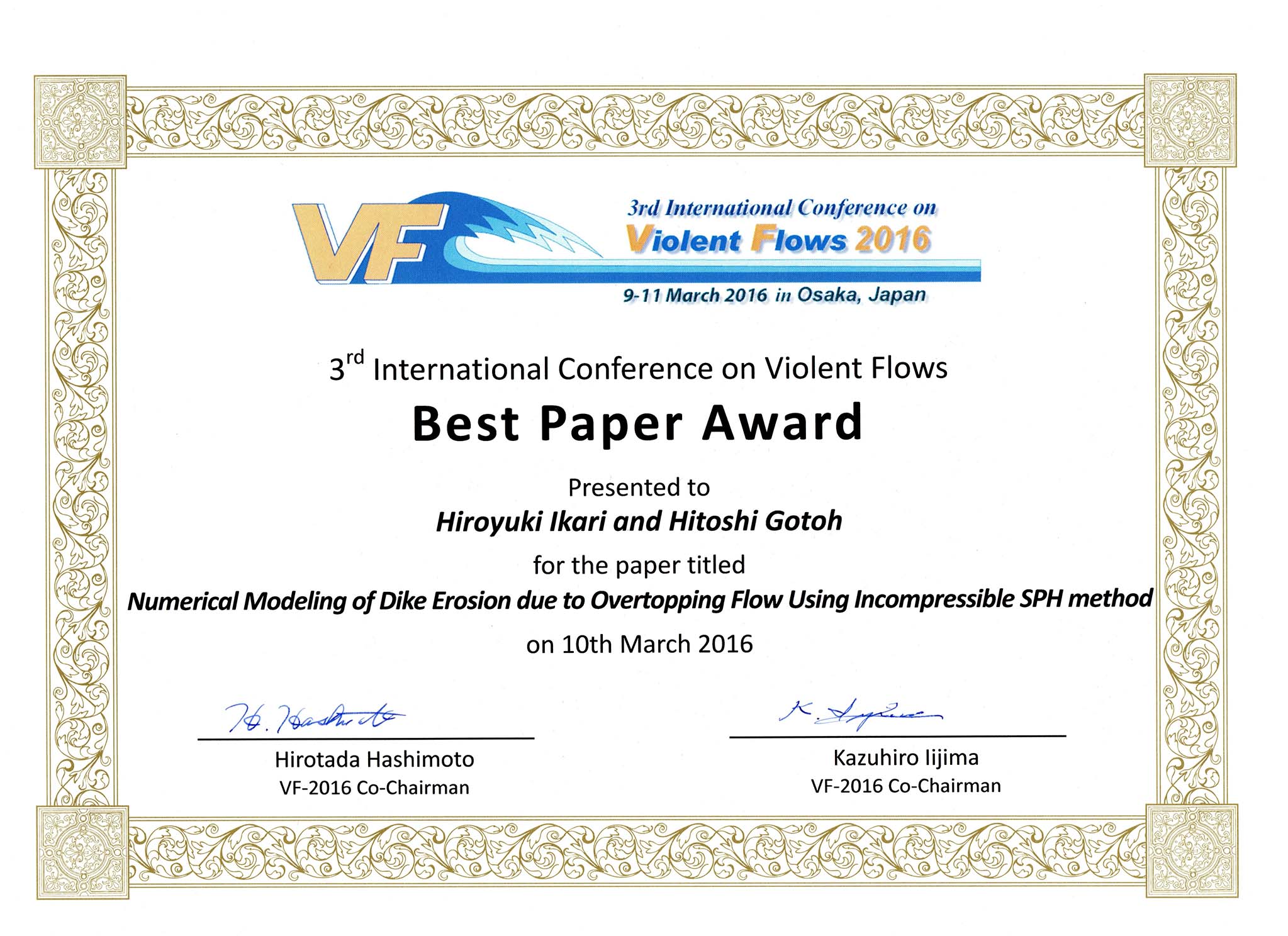
[Top position in Most Cited Applied Ocean Research Articles]
Our publication: A higher order Laplacian model for enhancement and stabilization of pressure calculation by the MPS method (Applied Ocean Research, Volume 32, Issue 1, February 2010) has been listed in the top position in the Most Cited Applied Ocean Research Articles(as of January, 2015). Another our publication:A 3D higher order Laplacian model for enhancement and stabilization of pressure calculation in 3D MPS-based simulations (Applied Ocean Research, Volume 37, Issue 1, August 2012) is also ranked at the 14th position in the Most Cited Applied Ocean Research Articles(as of January, 2015).
[2nd position in Top 25 Hottest Article(Applied Ocean Research)]
In the annual download ranking Top 25 Hottest Articles (Applied Ocean Research), January to December 2014 full year, our joint publication with PARI (Port and Airport Research Institute) : On enhancement of Incompressible SPH method for simulation of violent sloshing flows (Applied Ocean Research, Volume 46, 2014) listed in the 2nd position.
[Technical book “Computational Wave Dynamics” has been released.]
Technical book “Computational Wave Dynamics” has been released from World Scientific Publishing Co(June 7, 2013). From our research groupe, Gotoh serves as one of the editors and Harada serves as one of the authors of this book.
Computational Wave Dynamics
by Hitoshi Gotoh, Akio Okayasu and Yasunori Watanabe
234pp, ISBN: 978-981-4449-70-0, Hardcover, US$54
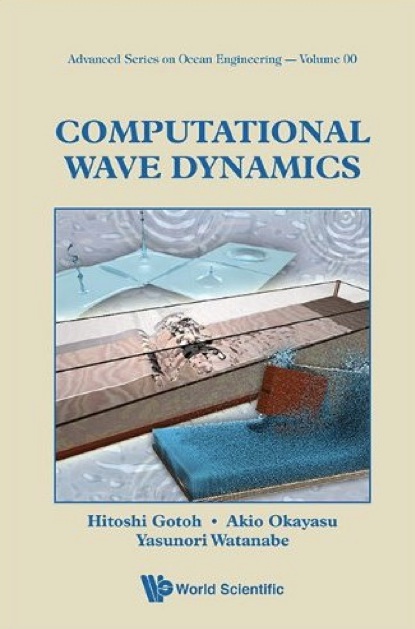
[Special Page] Particle Method Benchmark
Special page named “Particle Method Benchmark” provides various benchmark tests of violent flows simulated by our high-performance particle methods.
As a small introduction to our laboratory, keywords are shown as follows:
Coastal Engineering
As the Chair of Coastal Engineering at Kyoto University, our laboratory was originally founded in 1967 (see the page of “History”). The coastal engineering is a field dealing with disaster prevention, environmental preservation and human activities at a coast. We have worked on a wide theme from the coastal disaster prevention from a tsunami and a high tide, to the coastal environmental problems such as the ecosystem changes of an artificial beach. We also have contributed to a proposal and the advice for the coast management measures in the technical advisory committees of the national and the local governments.
Simulation Engineering
Although the coastal engineering is one of the most important research fields for us, we approach various research fields, such as a protection against flood disasters in a river basin, a technology for preservation of water environment and so on, by the advanced technology of computer simulation.
Particle Method
A particle method (SPH method and MPS method) is mainly investigated in our laboratory. Although a violent flow with whitecaps and splash, such as a wave breaking at a coast or a hydraulic jump in a river, was difficult to be simulated by the conventional numerical models of fluid, a simulation of a violent flow is enabled by a particle method, which is the Lagrangian solver of the equation of motion of fluid.
Development of Frontier Technology of Fluid Computation
Activities of our laboratory are not limited to applications of existing particle methods to various hydraulic phenomena. In our laboratory, a basic study of the calculation principle, which can be applied to all related fields of fluid science and engineering, is performed. SPS-Turbulence Model for turbulence calculations of the particle methods is a technique that is developed firstly by our laboratory members. Accurate particle methods (CISPH-HS method, CMPS-HS method, etc), which have been developed in our laboratory, have been published on international academic journals registered with ISI Web of Science of THOMSON-REUTERS. Our accurate particle methods have been referred not only in construction engineering but also in many research fields of fluid science and engineering. Publications on this subject won a higher rank (Top five) for the plural periods in the download ranking of the Science Direct “Top 25 Hottest Articles (Coastal Engineering and Applied Ocean Research )”.
- Corrected Incompressible SPH method for accurate water-surface tracking in breaking waves(Coastal Engineering, Volume 55, Issue 3, March 2008):2nd rank in 2011, 2012 and 2013 on Most Cited Coastal Engineering Articles.
- Modified Moving Particle Semi-implicit methods for the prediction of 2D wave impact pressure (Coastal Engineering, Volume 56, Issue 4, April 2009):5th rank in 2011, 4th rank in 2012 and 2013, 2nd rank in 2014 on Most Cited Coastal Engineering Articles.
- Enhanced predictions of wave impact pressure by improved Incompressible SPH methods (Applied Ocean Research, Volume 31, Issue 2, April 2009): 2nd rank in 2013, top rank in 2014 on Most Cited Applied Ocean Research Articles.
- A higher order Laplacian model for enhancement and stabilization of pressure calculation by the MPS method (Applied Ocean Research, Volume 32, Issue 1, February 2010): 6th rank in 2013, 3rd rank in 2014, top rank in 2015 on Most Cited Applied Ocean Research Articles.
These articles were listed on the download ranking of Science Direct, Top 25 Hottest Articles. Especially, the following articles are listed in the annual download ranking.
- The top rank in Top 25 Hottest Articles (Applied Ocean Research) in the Oct. 2009- Sep. 2010 Academic Year:Enhanced predictions of wave impact pressure by improved Incompressible SPH methods (Applied Ocean Research, Volume 31, Issue 2, April 2009)
- The 2nd rank in Top 25 Hottest Articles (Applied Ocean Research) in January to December 2014 full year:On enhancement of Incompressible SPH method for simulation of violent sloshing flows (Applied Ocean Research, Volume 46, 2014)
In addition, the following articles were listed the top of the download rankings.
- GPU-acceleration for Moving Particle Semi-Implicit Method (Computers and Fluids, Volume 51, Issue 1, December 2011) on Most Read Computers & Fluids Articles (as of December, 2011)
- On enhancement of Incompressible SPH method for simulation of violent sloshing flows (Applied Ocean Research, Volume 46, 2014) on Most Downloaded Applied Ocean Research Articles (as of July, 2014)
U.S. Patent, Patent No.8521466
The patent entitled as follows has been granted by the United States. “METHOD AND DEVICE FOR DETERMINING INTERFACE PARTICLE USED IN PARTICLE METHOD AND PROGRAM FOR DETERMINING INTERFACE PARTICLE”
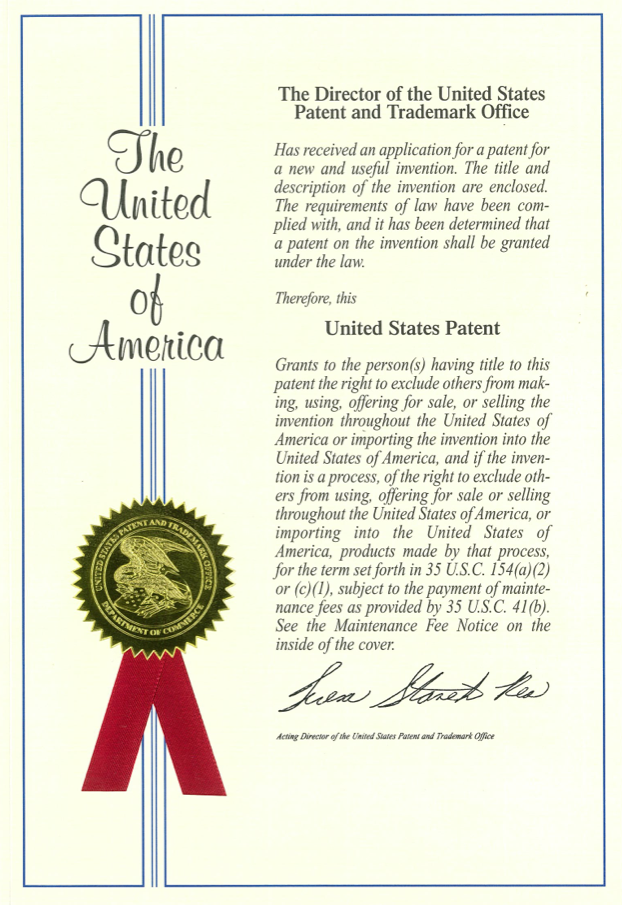
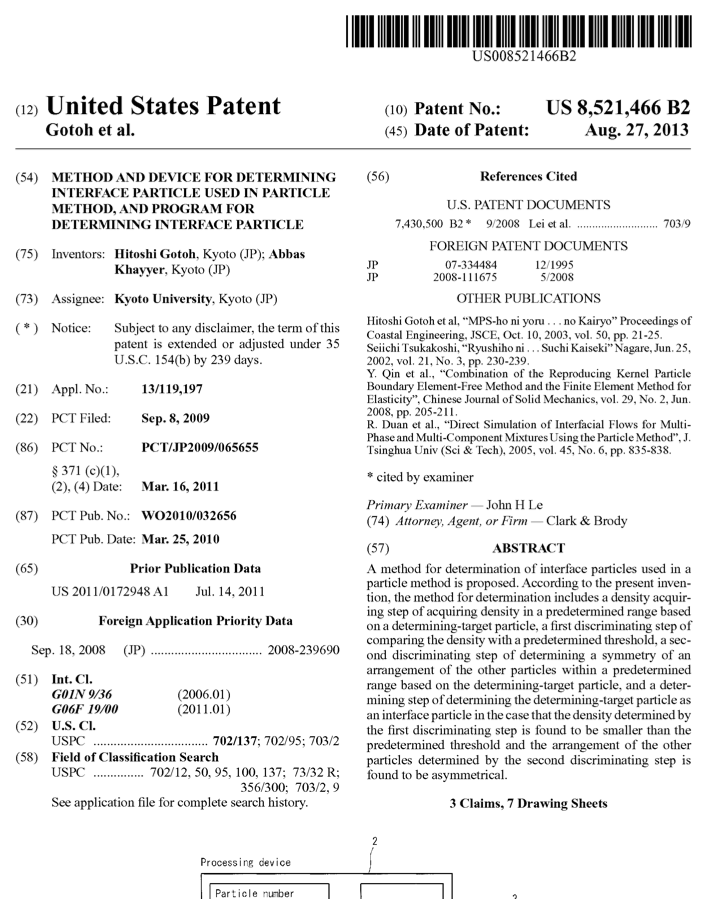
Link to patent No.8521466 in USPTO(United States Patent and Trademark Office). From Japan and the People's Republic of China, the patents with the same contents have been also granted.
Multi-physics by Particle Method
The target of the particle method is not limited to a fluid. The particle method is a general model of continuum, which can integrally describe an elastic body, a plastic body and a fluid. Large deformation phenomena that brought about difficulties in application of conventional technique, such as the FEM, can be analyzed by a particle method. The multi-physics that unify various phenomena in three major dynamics related to construction engineering, such as structural mechanics, soil mechanics and hydrodynamics, is possible. In our laboratory, the hybrid model of elasto-plastic body and fluid based on the particle method has been developed as a tool of interface fields between soil mechanics and hydrodynamics. This model can be applied to the prediction of a river-bank destruction due to a flood for urban disaster prevention.
Crowd Dynamics Model
If a person is regarded as a single particle, a crowd is a granular body with gathering particles. Auto traffic and the pedestrian crowd in urban areas can be interpreted based on the physics of a granular body. But because a person acts actively based on self-acquired information, the mathematical model of an active behavior is necessary. In our laboratory, the crowd behavior simulator CBS has been developed. CBS has been applied to disaster evacuations (CBS-DE), such as evacuations at the time of floods and tsunamis, evacuations at the time of the fire from the underground spaces (shopping center, a tunnel, etc.). CBS can be also applied to a pedestrian space design, such as a railway station square. Developing computational hardware will make an over-100,000 people scale calculation possible in near future. Construction of a Virtual City as the tool of the social experiment in a virtual space will be realized.
CG
Because over 1000,000 particles are tracked in the calculation of particle methods, a device that helps intuitive understanding of calculation results is indispensable. For example, in the numerical simulation of waves, a state as if we observe from a side of an experimental water tank is reproduced with CG. It is called Numerical Wave Flume. In addition, in crowd behavior simulator CBS, the model of a person with moving hands and feet is drawn. The CG and the dynamic image as post-processing of the simulation is indispensable for the interpretation of heavy computations performed in our laboratory.
Please refer to the page of [Researches] for detailed contents. In addition, dynamic images (animations) of the simulation results are shown in the page of [CG Gallery].

